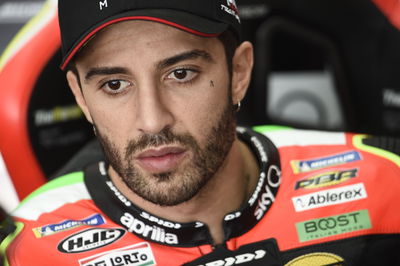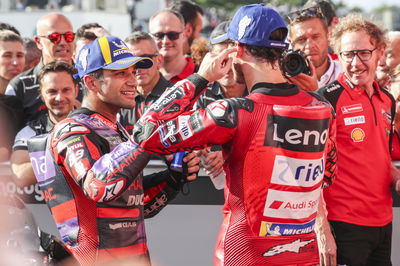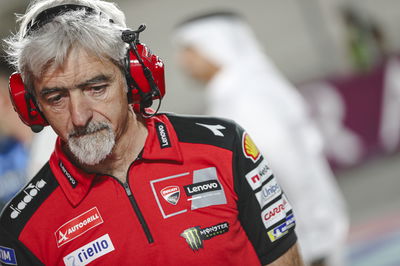OPINION: Does Andrea Iannone deserve a second-chance?
Ethical questions about Andrea Iannone cannot be ignored, writes Lewis Duncan

The last time I saw Andrea Iannone in the MotoGP paddock was at the post-season Jerez test in 2019.
After finishing a rain-hit second day 1.063s off the pace on the factory Aprilia, Iannone came to do a debrief in which he was short with the media and not in team gear.
Over his shoulder, Romano Albesiano walked out of the back of the garage, stopped to take a look at Iannone and shook his head in disapproval before walking off.
A few weeks later Iannone was hit with an 18-month FIM competition suspension for testing positive for Drostonalone - a banned anabolic steroid. Its original use was to treat breast cancer in women, though this is no longer the case, and can be used for performance and physique enhancement.
While the FIM upheld his claim that the drug - which can clear your system quickly - was ingested accidentally through contaminated meat in Malaysia, the Court of Arbitration for Sport (CAS) rejected this based on a lack of sufficient evidence presented by Iannone and the World Anti-Doping Agency’s appeal for a four-year maximum ban was upheld.
That verdict was read in November of 2020 and retroactively put in place from the previous November, rendering his Malaysian and Valencia GP results null. He lost his seat with Aprilia as a result and his racing career, at least as far as MotoGP was concerned, was done.
Iannone maintains to this day his innocence.
Does he really deserve redemption?
Andrea Iannone back on a MotoGP bike for the first time in five years & eight years since he last raced a Ducati in MotoGP 🇮🇹#MotoGP #MalaysianGP pic.twitter.com/DFz1ykuOtx
— Crash MotoGP (@crash_motogp) October 28, 2024
The evidence from the doping case is stacked against him, however, while his brags about how much weight he lost for the 2019 season - his first and only on the Aprilia, which was the grid’s heaviest machine at the time as it came in above the minimum weight limit - don’t reflect well.
Iannone’s is a curious case. His talent and speed were never in doubt from his early days in the grand prix paddock, with Marc Marquez last weekend in Thailand nodding towards the great battles he had with ‘the Maniac’ in Moto2.
Undoubtedly, Iannone’s speed should mean he should have more than one victory in the premier class. But he was his own worst enemy. The act of friendly fire in Argentina in 2016 against Ducati team-mate Andrea Dovizioso on the last corner of the last lap as both headed for the podium ultimately brought his time with the Italian marque to a close.
At Suzuki in 2017, his experience of good engines failed him as he selected the wrong direction for the Japanese marque to go in for its first season running without concessions. So poor were its results that it gained concessions back for 2018.
Throw in incidents like retiring from a wet San Marino GP because his rain suit was ostensibly too tight or missing pre-season testing ahead of his Aprilia debut in 2019 because he had cosmetic surgery on his jawline, and the case builds for this being a rider who probably didn’t deserve the opportunities he was given.
Arguably, Iannone was a lot more troubled than any of us realised but the surroundings of motorcycle racing don’t often offer on the ability to be candid about themselves for fear of showing weakness.
That aside, the defence of Iannone in recent weeks has been uncomfortably naive.
The 35-year-old is being spoken about by some as if he is a minor offender who’s been nicked for a few petty break-ins.
He doped. That’s the basic facts of it.
Unlike a lot of drugs cheats, Iannone maintained a good level of support from the motorcycle racing community. Aprilia stood by him throughout his appeal proceedings, while last year Gigi Dall’Igna of Ducati spoke to him about a possible World Superbike return in 2024 once his four-year ban was up.
GoEleven lined up a good ride for him on a Panigale V4 in WSBK for 2024, on which he was competitive and managed a race win at Aragon. After four years away, Iannone was given a chance to prove his speed at the highest level in motorcycle racing outside of MotoGP.
Anything more than that is unmerited.
Can he really be quick in MotoGP again?
What’s perhaps most frustrating about this is Iannone has been given a chance over a younger talent with more MotoGP prospects than he does now.
Nicolo Bulega’s rookie season in WSBK saw him finish runner-up in the standings as he continues on his career rebuild after stepping away from the VR46 Academy and the grand prix paddock to try his hand in Superbikes. The Supersport title last year earned him his WSBK step, and he’s made it count.
At 25, Bulega has more prospects of being on the MotoGP grid in the future if he continues to impress. It’s not clear what Bulega’s relationship with VR46 is like now, though reigning MotoGP world champion Francesco Bagnaia picked him as his preferred option to be Di Giannantonio’s stand-in.
MotoGP has to look at itself and ask: what is the point in opportunities like this if not to reward young, fast riders?
Regardless, VR46 and Ducati have made their decision, and it’s one WADA itself has no issue with.
“Under the terms of the World Anti-Doping Code, once an athlete has served the imposed period of ineligibility, he or she is free to return to participation. The level of competition is not relevant to this,” it said in a statement issued to Crash.net.
But what can reasonably be expected of Iannone at Sepang?
Iannone didn’t cover himself with glory upon stepping away from the Ducati family in 2017. In his first year on the underwhelming GSX-RR, he was only 11 points clear of rookie team-mate Alex Rins - who missed fives races with injury - in the standings. In 2018 he was on the podium four times, but Rins managed five and beat him by 36 points.
He didn’t disgrace himself against Aleix Espargaro in an injury-plagued 2019 on the Aprilia, with 20 points splitting them in the end. And that was hit for Iannone’s MotoGP career.
Since 2019, MotoGP bikes have changed quite dramatically. Iannone raced at a time when aero development wasn’t at as an advanced stage as it is now, while ride height devices were in their infancy. And sprint races were never a consideration. Without a test ahead of Sepang, Iannone is taking a big leap.
In 2024, Remy Gardner has been the only WSBK rider to have made the jump onto a MotoGP bike so far, doing so three times for Yamaha in Germany, Britain and Japan.
Gardner was 0.987s off the pace of the next-best Yamaha in qualifying in Germany, while he was 32.9s away in the grand prix. In Britain he was 0.795s shy in qualifying and was 34.935s back in the race. In Japan, his qualifying deficit to the nearest Yamaha was 1.042s and 18.708s in the race. Gardner, of course, has more recent MotoGP experience of the KTM from his 2022 season.
In Malaysia last year, double WSBK champion Alvaro Bautista made a wildcard with Ducati. He was 1.507s off the nearest Ducati in Q1 and 33.824s behind in the grand prix, though Bautista was carrying injury from a testing crash.
Danilo Petrucci stepped onto a factory Ducati at Le Mans last year to finish 11th, though had raced a MotoGP bike in 2022 in Thailand as a Suzuki stand-in and was in the series full-time until the end of 2021.
Maybe the most relevant recent example of a WSBK-to-MotoGP one-off was Garrett Gerloff’s in 2021. On an ageing Petronas SRT Yamaha at Assen, the American was 0.820s off the next M1 in qualifying (and 1.198s from progressing to Q2) and 50.456s behind the next Yamaha down in 17th (second-to-last of the classified runners).
By virtue of being on a Ducati at Sepang, Iannone has a strong chance of not being last all weekend. But anything near the top 15 is not likely, nor is it realistic to expect given his time away.
What happens after?
Iannone is unlikely to change his stance on his doping ban anytime soon, and a return to racing in MotoGP is only going to strengthen his stubbornness on this. How he fields the media in Malaysia will offer a better insight into the kind of character he is now.
Whatever happens, the Malaysian GP will likely be the cadence to Iannone’s intriguing, if frustrating, career in grand prix racing.
With no confirmation of who will replace Di Giannantonio in Valencia, it’s hard to look past Ducati eyeing up Michele Pirro for that ride. The concession system for 2024 has meant Ducati has been unable to field Pirro in any wildcards, thus missing out on crucial in-race test running and several chances to reward the veteran rider for his continued efforts in the marque’s total MotoGP domination.
With an important post-season test on the Tuesday after Valencia, it would make the most sense to put Pirro on the second VR46 bike to run through some things.
As for the overarching narrative here of how far should we go in the rehabilitation of riders, there is probably never going to be a happy medium. The Iannone case is easier for most to reckon with: he wasn’t a world champion, he wasn’t a serial winner in MotoGP and was likely never going to be on an Aprilia.
But, like it or not, this does also set the precedent now…












